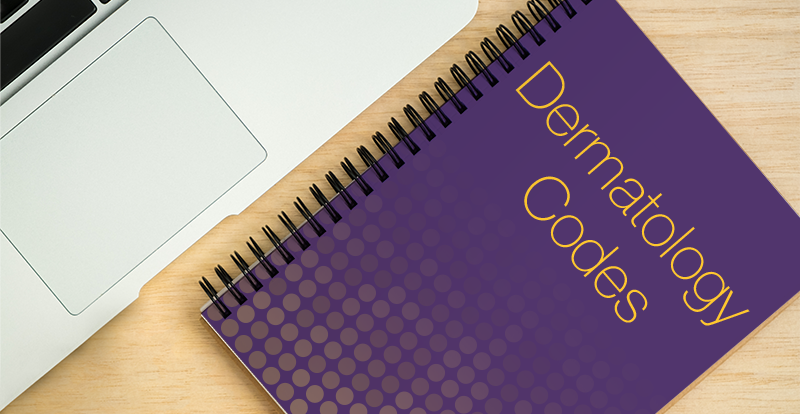Dermatology CPT® Codes for 2019

Changes in Skin Biopsy Codes
This post was originally published on May 24, 2018 and updated on January 11, 2019.
Beginning on January 1, 2019, skin biopsy CPT coding has changed to include greater specificity by distinguishing the technique used to biopsy a lesion. This article will review the 2019 skin biopsy coding rules and rationale by the American Medical Association (AMA) and helpful guidelines found on CMS.gov.
| 2018: Dermatology CPT Codes | 2019: Dermatology CPT Codes |
|---|---|
| 11100 Skin Biopsy Single Lesion | 11102 Tangential Skin Biopsy Single Lesion |
| 11101 Skin Biopsy Ea Sep/Additional Lesion | 11103 Tangential Skin Biopsy Ea Sep/Additional Lesion |
| 11104 Punch Skin Biopsy Single Lesion | |
| 11105 Punch Skin Biopsy Ea Sep/Additional Lesion | |
| 11106 Incisional Skin Biopsy Single Lesion | |
| 11107 Incisional Skin Biopsy Ea Sep/Additional Lesion |
In 2019, skin biopsy CPT codes 11102-11107 are distinguished using three different techniques. They include tangential (shave) biopsy, punch biopsy and incisional biopsy. If only one biopsy technique is performed, the coding is straightforward. You should select the CPT code(s) associated to technique. Use the primary code for the first lesion and each additional code for each additional biopsy.
When physicians perform different biopsy techniques in one session, the coding becomes more complex. According to the AMA CPT guidelines, only one primary skin biopsy in the coding range 11102-11107 can be utilized per encounter regardless of the biopsy technique. If more than one technique is performed, refer to the “each additional lesion” code matching the technique of the additional biopsies.
This clarification is made on “Change Report for Add-on Code Edit Changes 1/01/2019 for Medicare” found on the CMS National Correct Coding Edit page which is in the table below.
| Add-on Code | Primary Code(s) | Effective Date | Deletion Date | CPT Instruction |
|---|---|---|---|---|
| 11103 | 11102, 11104, 11106 | 1/1/19 | "▶(Report 11103 in conjunction with 11102, 11104, 11106, when different biopsy techniques are performed to sample separate/additional lesions for each type of biopsy technique used)◀" | |
| 11105 | 11104, 11106 | 1/1/19 | "▶(Report 11105 in conjunction with 11104, 11106, when different biopsy techniques are performed to sample separate/additional lesions for each type of biopsy technique used)◀" | |
| 11107 | 11106 | 1/1/19 | "▶(Report 11107 in conjunction with 11106)◀" |
Other rules to consider when line item billing a claim with multiple biopsies is found in the 2019 CMS 2019 PFS National RVU file named “PPRRVU19_Jan” including:
- Non-facility RVU total or facility RVU total columns
- Multiple procedure indicator column
Additional site specific biopsy CPT codes did not change in 2019. Some commonly used site specific biopsies include:
- 11755 – Biopsy of Nail Unit
- 69100 – Biopsy of Ear
- 67810 – Biopsy of Eyelid Margin
- 54100, 57100, 56605 or 56606 – Biopsy codes for Genitalia
Modernizing Medicine’s dermatology electronic health record (EHR) system, EMA™, helps suggest automated codes based on what the provider documents in a visit to reflect the 2019 dermatology skin biopsy codes.
Sources
Centers for Medicare and Medicaid (CMS). RVU19A. https://www.cms.gov/Medicare/Medicare-Fee-for-Service-Payment/PhysicianFeeSched/PFS-Relative-Value-Files-Items/RVU19A.html. Published December 20, 2018. Accessed December 24, 2018.
Centers for Medicare and Medicaid (CMS). Add-on Code Edits. https://www.cms.gov/Medicare/Coding/NationalCorrectCodInitEd/Add-On-Code-Edits.html. Published December 10, 2018. Accessed December 24, 2018.
American Medical Association. CPT Changes 2019: An Insider’s View. American Medical Association. Published November 10, 2018. Accessed December 10, 2018.
Some of the top dermatology CPT code changes
Please note, the post below is from May 24, 2018.
A few changes and new codes included in the American Medical Association (AMA) 2018 CPT® Professional book impact dermatology. Descriptors for some CPT codes were updated, along with new CPT codes to better show a provider’s direct involvement in the treatment or procedure. Please note that the descriptors detailed below for each of the dermatology CPT codes were sourced directly from the AMA 2018 CPT Professional book.
One update includes a revision to CPT code 96567 which includes editorial changes and introduces two new codes.
Photodynamic Therapy (PDT)
- Per the AMA’s CPT 2018: Professional Edition book, 96567 is for Photodynamic therapy (PDT) by external application of light to destroy premalignant lesions of the skin and adjacent mucosa with application and illumination/activation of photosensitive drug(s), per day.
- Per the AMA’s CPT 2018: Professional Edition book, they recommend not using this code when a physician or qualified healthcare provider is not directly involved in providing the PDT treatment. This is a revised code.
- Per the AMA’s CPT 2018: Professional Edition book, 96573 is for PDT by external application of light to destroy premalignant lesions of the Understanding Phototherapy Services skin and adjacent mucosa with application and illumination/activation of photosensitizing drug(s) provided by a physician or other qualified healthcare professional, per day. Per the 2018 CPT book published by AMA, they recommend not reporting 96567, 96574 with 96573 for the same anatomic area.
- Per the AMA’s CPT 2018: Professional Edition book, 96574 is for Debridement of premalignant hyperkeratotic lesion(s) (i.e. targeted curettage, abrasion) followed with photodynamic therapy by external application of light to destroy premalignant lesions of the skin and adjacent mucosa with application and illumination/activation of photosensitizing drug(s) provided by a physician or other qualified healthcare professional, per day. Per the 2018 CPT book published by AMA, they recommend not reporting 96567 or 96573 with 96574 for the same anatomic area. This is a new code.
The first new PDT code 96573 will help identify PDT and where the photosensitizing agent is applied by the physician or by another qualified healthcare provider. Whereas, the second PDT code 96574 will address photodynamic therapy when the provider debrides hyperkeratotic lesions prior to treatment.
Chemical Cauterization
- Per the AMA’s CPT 2018: Professional Edition book, 17250 for chemical cauterization of granulation tissue now includes only proud flesh, deleting sinus or fistula from the description.
Wound Reconstruction (Flap)
- Per the AMA’s CPT 2018: Professional Edition book, 15730 has been added to describe Midface skin flap reconstruction (i.e., zygomaticofacial flap) with preservation of vascular pedicle(s).
- Deleted 15732 for Muscle, myocutaneous or fasciocutaneous flap head and neck. This is a deleted code as per the AMA’s CPT 2018: Professional Edition book.
- Per the AMA’s CPT 2018: Professional Edition book, 15733 (replaces 15732) for Muscle, myocutaneous or fasciocutaneous flap; head and neck with named vascular pedicle (i.e. buccinators, genioglossus, temporalis, masseler, sternocleidomastoid, levator scapulae).
Healthcare Common Procedure Coding System (HCPCS)
- New HCPCS Drug Code for Tremfya for treatment of severe plaque psoriasis C9029 Injection, guselkumab, 1mg as per the AMA’s CPT 2018: Professional Edition book
Our dermatology EHR system, EMA™, reflects these updates as the dermatology CPT codes are automatically generated. When your practice has access to the most up-to-date coding guidelines and information about regulations, you may have the potential to obtain maximum reimbursements. Such automatic coding can help increase efficiencies and productivity in your practice.
Source
The American Medical Association. CPT® 2018: Professional Edition. 2017. Print.






